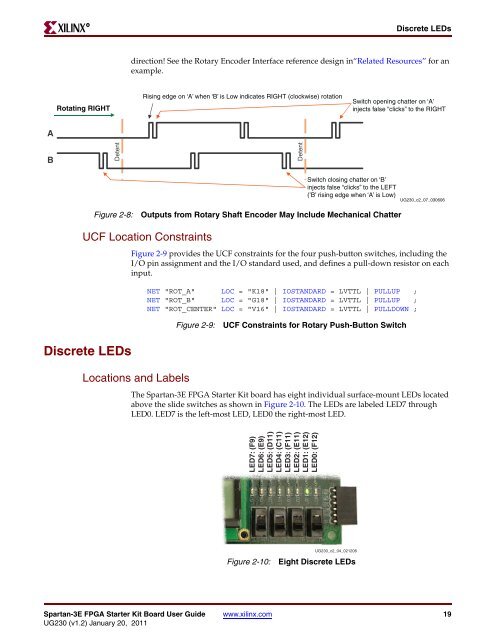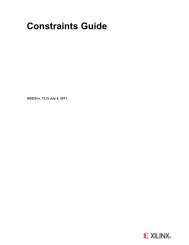Xilinx UG230 Spartan-3E FPGA Starter Kit Board User Guide
Xilinx UG230 Spartan-3E FPGA Starter Kit Board User Guide
Xilinx UG230 Spartan-3E FPGA Starter Kit Board User Guide
Create successful ePaper yourself
Turn your PDF publications into a flip-book with our unique Google optimized e-Paper software.
A<br />
Rotating RIGHT<br />
B Detent<br />
R<br />
Discrete LEDs<br />
direction! See the Rotary Encoder Interface reference design in“Related Resources” for an<br />
example.<br />
UCF Location Constraints<br />
Discrete LEDs<br />
Figure 2-8: Outputs from Rotary Shaft Encoder May Include Mechanical Chatter<br />
Figure 2-9 provides the UCF constraints for the four push-button switches, including the<br />
I/O pin assignment and the I/O standard used, and defines a pull-down resistor on each<br />
input.<br />
Locations and Labels<br />
Rising edge on ‘A’ when ‘B’ is Low indicates RIGHT (clockwise) rotation<br />
The <strong>Spartan</strong>-<strong>3E</strong> <strong>FPGA</strong> <strong>Starter</strong> <strong>Kit</strong> board has eight individual surface-mount LEDs located<br />
above the slide switches as shown in Figure 2-10. The LEDs are labeled LED7 through<br />
LED0. LED7 is the left-most LED, LED0 the right-most LED.<br />
<strong>Spartan</strong>-<strong>3E</strong> <strong>FPGA</strong> <strong>Starter</strong> <strong>Kit</strong> <strong>Board</strong> <strong>User</strong> <strong>Guide</strong> www.xilinx.com 19<br />
<strong>UG230</strong> (v1.2) January 20, 2011<br />
Detent<br />
Switch opening chatter on ‘A’<br />
injects false “clicks” to the RIGHT<br />
Switch closing chatter on ‘B’<br />
injects false “clicks” to the LEFT<br />
(’B’ rising edge when ‘A’ is Low)<br />
NET "ROT_A" LOC = "K18" | IOSTANDARD = LVTTL | PULLUP ;<br />
NET "ROT_B" LOC = "G18" | IOSTANDARD = LVTTL | PULLUP ;<br />
NET "ROT_CENTER" LOC = "V16" | IOSTANDARD = LVTTL | PULLDOWN ;<br />
Figure 2-9: UCF Constraints for Rotary Push-Button Switch<br />
LED7: (F9)<br />
LED6: (E9)<br />
LED5: (D11)<br />
LED4: (C11)<br />
LED3: (F11)<br />
LED2: (E11)<br />
LED1: (E12)<br />
LED0: (F12)<br />
<strong>UG230</strong>_c2_04_021206<br />
Figure 2-10: Eight Discrete LEDs<br />
<strong>UG230</strong>_c2_07_030606












